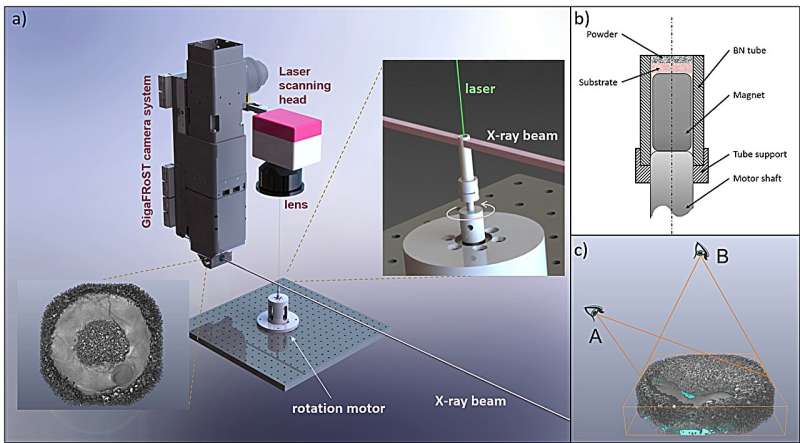This article has been reviewed according to Science X's editorial process and policies. Editors have highlighted the following attributes while ensuring the content's credibility:
fact-checked
trusted source
proofread
3D insights into an innovative manufacturing process

3D printing can produce highly complex shapes. But printing ceramic objects with the help of a laser is a more difficult challenge. Now researchers at the Paul Scherrer Institute PSI have for the first time taken tomograms revealing what happens at microscopic level during this fabrication process. The findings will help improve this very promising technology.
3D printing is already being used to produce many objects. Additive manufacturing is increasingly being used in the aerospace and automotive industry, for example, as well as in medicine.
The method commonly used for metals and plastics is known as laser-based powder bed fusion (LPBF). In LPBF, the material is applied as a fine powder layer on a substrate and then the laser passes over the powder and melts it to form it into the desired shape. The next thin layer of powder is deposited and once again melted by the laser. The component is built up sequentially in this way, layer by layer.
Exactly what happens during the LPBF process has already been investigated using X-rays at the Swiss Light Source SLS at PSI and fellow research institutes, but these microscopic insights have only provided 2D images to date.
"We wanted to go one step further and track the manufacturing process in 3D," says Malgorzata Makowska, material scientist at PSI. Instead of 2D X-ray images, the researchers wanted to obtain 3D tomograms with a speed allowing them to follow the laser spot. To do so, they had to rotate their sample during the manufacturing process and track this rapid rotary movement with the laser—a major challenge. For the first time, the team has now managed to do this, as reported in the journal Communications Materials.
Magnet stabilizes a rotating precursor powder
The scientists used aluminum oxide for their experiments. This ceramic material is typically used, for example, in the chemical industry for components exposed to high temperatures, in electrical engineering as an insulator, or in medicine for implants. Because this material is extremely hard and brittle, however, fabricating complex shapes with conventional technology presents huge challenges.
"It would be much easier if one could print such components," says PSI physicist Steven Van Petegem. "When printing aluminum oxide, however, it's still difficult to obtain a sufficiently dense material and the desired microstructure."
The experiments conducted at the SLS tomography beamline TOMCAT offered new insights into the innovative manufacturing process. The test sample rotated at a speed of 50 Hz (3000 rpm), while the laser traveled over the powder. Adapting the printing process to this extremely rapid rotation was one of the main difficulties, which the researchers have now overcome.
Another challenge was to prevent the rotating material drifting apart as a result of centrifugal forces. They achieved it by adding a tiny amount of magnetic iron oxide into the aluminum oxide powder particles and then incorporating a magnet to keep the powder in place. The magnet was mounted beneath the sample in a small cylinder with a 3 mm diameter.
"Thanks to the fast GigaFRoST camera, an in-house PSI development, and a highly efficient microscope, it was possible to acquire 100 3D images each second during the printing process," explains beamline scientist Federica Marone. These images showed what happened to the powder during the laser treatment.
"For the first time we were able to directly visualize the melted volume in 3D," says Makowska. The shape of the so-called 'melt pool' surprised the researchers. When they increased the power of the laser, no depression formed on the surface, as expected. "Instead the melt pool spread out like a pancake and the surface was more or less flat," the material scientist comments.
Printing the desired microstructure
The researchers could also observe how pores and hollows formed as the material hardened, which is important for future applications. "Ideally one would like to have a smooth, attractive material with a well-defined microstructure. But a certain amount of porosity is also very desirable for specific applications," explains Makowska.
Van Petegem adds, "We hope our experiments will reveal more about the printing process and that we can pass on this knowledge, so that it can be put to practical use, even if there is still a long way to go." The upgrade of the SLS machine starting soon and the new TOMCAT 2.0 beamlines coming into operation in 2025 will enhance the current capabilities. "It will become possible to study denser material with higher spatial and temporal resolution, key aspects for bringing the LPBF technology further," says beamline scientist Christian Schlepütz.
The study was made with the collaboration of the technology competence center Inspire AG, ETH Zurich and Empa. The idea for this research was a follow-up of the Fuorclam project launched in 2017 within the frame of a Strategic Focus Area (SFA) Advanced Manufacturing program.
"The various projects have given us the opportunity to get to know all the groups in Switzerland engaged in research into additive manufacturing and 3D printing," says Van Petegem. "This is an extremely important topic for the future, which Switzerland has acknowledged."
More information: Malgorzata G. Makowska et al, Operando tomographic microscopy during laser-based powder bed fusion of alumina, Communications Materials (2023). DOI: 10.1038/s43246-023-00401-3 www.nature.com/articles/s43246-023-00401-3




















